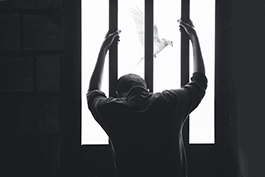How Restorative Justice Helped Make the Justice System Work Better in Seattle
- MATTHEW MCDONALD
The Archdiocese of Seattle participated in a pilot program for selected juvenile offenders.
 When he first heard about "peacemaking circles" as a tool of "restorative justice," Judge Wesley Saint Clair responded with a barnyard epithet.
When he first heard about "peacemaking circles" as a tool of "restorative justice," Judge Wesley Saint Clair responded with a barnyard epithet.
"I was highly skeptical," said Saint Clair, now a retired superior court and juvenile court judge who saw plenty of bad guys during his 30 years on the bench in Seattle. "I said, 'I don't want to hold hands. I don't want to sing Kumbaya. And I sure as hell don't want to smoke any dope with you guys.'"
But after seeing the circles in action, Saint Clair changed his mind. "And I went from being an ardent skeptic to a Kool-Aid maker," he said.
Peacemaking circles are among a series of diversionary programs in the criminal-justice system that try to break cycles of incarceration by avoiding incarceration. It's one group's answer to the question: How do we make the criminal-justice system work better?
The Archdiocese of Seattle participated in a pilot program in King County several years ago. The program centered on selected juvenile offenders, ages 15 to 17, whose crimes were serious enough to warrant detention (the juvenile form of jail) but not serious enough to warrant adult prison.
If the victim agreed to it, the offender could avoid lockup by participating instead in twice-a-month sessions over the course of a year. The goal wasn't punishment so much as healing.
Intense Sessions
The offender sat in a circle with members of the community affected by what he did — the victim, for starters, if the victim wanted to participate — and a mediator, prosecutors, a judge, probation officers, his family members, and family members of the victim. A typical session drew about 15 people but could balloon to as many as several dozen, said Joe Cotton, director of pastoral care and outreach for the Archdiocese of Seattle who participated in the sessions.
At the outset, the offender agreed to admit to what he did. He also agreed to make restitution to try to make the victim whole.
The first session was a raw telling of events. "So truth-telling is at the core of it," Cotton said.
Future sessions tried to get at why the offender did it. Participants heard stories of poverty, trauma, neglect, abuse, violence, drugs, mental illness and anger leading to criminal behavior. But the offender also heard from the victim or his representatives about the harm the defender did through his crime, in an attempt to get him to see his victim as a person with dignity and rights.
It wasn't a cursory review. Each session took at least three hours, Cotton said. A single case could lead to 20 such sessions during the year.
While some offenders went into the program seeing it as a get-out-of-jail free card they could use to game the system, it became clear shortly into it that they were in for a bumpy ride, Cotton said.
For some, confronting their emotional pain and character deficiencies was worse than the punishment the judge would have meted out.
"You have to get to a point where you either deal with it or you opt out of the process. As an example, one of our participants stated, 'Oh my goodness, just send me to jail. It's easier,'" Cotton said.
Atonement
While peacemaking circles are not a specifically religious idea, Cotton sees the process and the results in Catholic spiritual terms.
If an offender continues with the program, Cotton said, it leads to what he called "real transformation" that can "really heal this harm."
"In other words, it's resurrection. It's life, death and resurrection — entering into the Paschal Mystery," Cotton said.
Father Jay DeFalco, a priest of the Archdiocese of Seattle who serves as Catholic prison chaplain at the county jail and juvenile detention facility in Snohomish County and the state prison in Monroe, told the Register he has seen peacemaking circles help not just offenders but also their families.
"With young people, it seems to work very effectively," Father DeFalco said. "It's teaching them empathy, it's teaching them listening skills, and it's teaching them ways to deal with aggression and fear."
Reestablishing Community
One close observer of the criminal-justice system would like to see more community involvement in such alternative methods of dealing with crime — perhaps instead of jury duty.
Kathryn Getek Soltis, an assistant professor of Christian ethics at Villanova University who has volunteered in Catholic prison ministry in Massachusetts and Pennsylvania, finds the current criminal-justice system imprecise and too impersonal.
"Just because you make someone suffer for what they did doesn't mean you have held them accountable."
"Just because you make someone suffer for what they did doesn't mean you have held them accountable," Getek Soltis said. "Restorative justice has to involve the community in a really robust way, as a stakeholder. Most of the time, the citizenry leaves the justice system to deal with the law. This is the responsibility of everybody in the community, and restoration isn't something we can outsource. It doesn't work unless we're all involved in it."
One crime expert cautions that in order to be effective such approaches must be well-structured and thorough, with a mediator to guide them so they don't devolve into shouting sessions.
But done properly, such methods foster "the most natural human response to crime — to try to talk things through and resolve the conflict," said Jeffrey Butts, director of the Research and Evaluation Center at John Jay College of Criminal Justice in New York City.
Reconnecting people after harm takes time and effort, he said.
"But that's the whole theme of it: You want to rebond somebody to conventional notions of morality," Butts said. "You reestablish a human bond, a human perspective. … The whole idea behind restorative justice is to broaden one's awareness of community and the family of humanity and to have them feel that basic respect for someone."
Traditional reactions to crime tend to fall into one of two categories: Punish and exact retribution; or use therapy to try to figure out root causes. Restorative justice, Butts said, adds a social dimension that is missing from both.
"It's a little like bringing this person back into the community. It's not just about their inner defects. It's about their sociological connection, their social bonds," Butts said.
How Did It Go in Seattle?
In Seattle, organizers of the peacemaking-circles program met with several encouraging successes and one giant failure.
One offender, who had robbed another teenager with an air-soft gun and seemed on a path toward crime and jail, after completing the program graduated from high school, attended community college, got a job, and volunteered with circles training. He has had no involvement with the criminal-justice system since, Cotton said.
The young man's victim had agreed to allow his robber into the circle process but decided not to participate himself. Sometime after the circle process ended, the offender went to a Chick-fil-A and was surprised to see his victim on the other side of the counter, taking his order. The offender, Cotton heard later, thanked his victim for allowing him into the circle program, which he said changed his life.
"And so his victim came around the counter, and the two of them are now hugging each other in a Chick-fil-A," Cotton said. "And so I would say that's the kingdom of heaven. That's the lion lying down with the lamb."
In a different circles program, Saint Clair, the judge, described a case where a young adult helped others rob a store owned by a middle-aged man who had acted as a mentor to him — adding betrayal to theft.
Both the offender and the victim were from East Africa. The victim insisted on a peacemaking-circle process.
The victim was practical: He was out about $2,000 in the robbery, and he demanded it back. The young man's family came up with the money.
The victim also forced the young man to confront the gravity of what he had done, while learning about the poverty and other deficiencies that influenced the young man to do what he did. The two men reconciled — a feature of the peacemaking circles that Saint Clair said he didn't see using conventional criminal-justice methods such as jail sentences.
"Some people thought it was soft on crime. But were one ever able to witness a circle occurring, the depth of the conversation therein … it's clear that this is no walk in the park. This is a lot of work," Saint Clair said.
In King County, the pilot program lasted from 2016 to 2018. It ended after one of the offenders was arrested and charged with killing a 15-year-old boy during a drug-deal-turned-robbery. (He later pleaded guilty to second-degree murder.)
Cotton and Saint Clair said the circles program was wrongly associated in the public mind with the murder. The suspect would have been out of detention at the time of the killing if he had gone the traditional sentencing route and the killing had nothing to do with the program, they said.
Cotton and Saint Clair said they hope that a new prosecutor (to be elected this fall, since the current one is not running for reelection) will consider bringing the circles program back. (A spokesman for the King County prosecuting attorney's office could not be reached by deadline for this story.)
A key part of the circle program, Cotton said, is that it isn't just a service offered to someone who has committed a crime.
"I don't think our current system does a great job of facilitating healing for survivors of crime," Cotton said. "The current system tries to function where the response is to provide punishment for the one who has committed harm. Better than punishment for all, why not healing for all?"
 This is Meaghen Gonzalez, Editor of CERC. I hope you appreciated this piece. We curate these articles especially for believers like you.
This is Meaghen Gonzalez, Editor of CERC. I hope you appreciated this piece. We curate these articles especially for believers like you.
Please show your appreciation by making a $3 donation. CERC is entirely reader supported.

Acknowledgement
 Matthew McDonald. "How Restorative Justice Helped Make the Justice System Work Better in Seattle." National Catholic Register (March 9, 2022).
Matthew McDonald. "How Restorative Justice Helped Make the Justice System Work Better in Seattle." National Catholic Register (March 9, 2022).
© 2022 EWTN News, Inc. Reprinted with permission from the National Catholic Register. Image credit: Photo by Hasan Almasi on Unsplash.
The Author
Matthew McDonald is a staff reporter for The National Catholic Register and the editor of New Boston Post. He lives in Massachusetts.
Copyright © 2022 National Catholic Register



